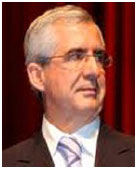Milton Ruiz Alves
DOI: 10.17545/e-oftalmo.cbo/2017.103
“Whoever chose the pursuit cannot refuse the crossing" (Guimarães Rosa)
The World Health Organization (WHO) estimates that 285 million people have visual impairment (VI) worldwide, and of these, 39million are blind. Poor populations and older adults are most severely affected; 82% of the blind individuals and 65% of the moderately-to-severely blind individuals are aged ≥50 years. VIs, including blindness, are preventable in approximately 80% of thecases.1
Data from the Brazilian Census of Geography and Statistics (Instituto Brasileiro de Geografia e Estatística, 2000) indicate that VI is the predominant type of disability in the 24.5 million individuals with disabilities in Brazil, accounting for 48.1% of all reported cases.2 The estimated loss of gross domestic product in Brazil due to uncorrected refractive errors is 0.18% (approximately R$ 8.7 billion).3 Therefore, VIs, including blindness, in individuals, families, and communities have a significant social importance because they cause severe social, economic, and educational problems (failures and dropouts) and subsequently difficulties in social or inadequate insertion in the labor market. Demographic explosion, population aging, and increased demand for social inclusion together with the increasing semiological and therapeutic means surpass the available resources. Therefore, it is essential to carefully evaluate which problems will be thoroughly addressed, partially addressed, or postponed.4
As part of its commitment to ensure access of the Brazilian population to ocular health, the Brazilian Council of Ophthalmology (CBO) has established the Increased Access to Ocular Health Program (Programa Mais Acesso à Saúde Ocular)5, which is a proposal for the nationalexpansion of ophthalmologic care, particularly for the poor population, wherein healthcare is limited. CBO proposes the following actions to assist this population and increase their access to ocular health: 1) encourage the installation of ophthalmological centers in priority areas for the Unified Health System (SUS); 2) include ophthalmology in the primary care of SUS; 3) create a differentiated remuneration table at priority locations for SUS; 4) combine actions to stimulate the formation of medical residencies and internships in unassisted areas; 5) include technologies to monitor the primary causes of blindness and poor vision, and 6) implement a national health quality assessment system.
The WHO Global Action Plan 2014–2019 intends to prevent VI due to preventable causes to enable individuals to reach their full potential and provide universal access to comprehensive ophthalmologic care services.1 CBO, via the Increased Access to Ocular Health Program, is aligned with WHO’s 2014–2019 plan of action and has contributed to the improvement of structured, efficient, and equitable health systems, which are crucial for the promotion of the quality of life.
REFERENCES
1. Projeto de Plano de Ação para a Prevenção da Cegueira e de Deficiência Visual evitáveis 2014-2019. 66ª Assembleia Mundial de Saúde. Disponível em: https://visao2020la.files.wordpress.com/2013/08/2-projeto-de-plano-de-ac3a7ao.pdf. Acesso em: 03 maio 2017.
2. IBGE (Instituto Brasileiro de Geografia e Estatística). Deficiência. disponível em: http://www.ibge.gov.br/home/presidencia/noticias/08052002tabulacao.shtm Acesso em: 01 maio 2017.
3. Carvalho KM, Ventura LMVO, Alves MR, Resnikoff S.Estimativa global do custo da correção óptica da baixa visão por erro de refração não corrigido. In: Alves MR, Nishi M, Carvalho KM, Ventura LMVO, Schellini S, Kara-José N. (eds). Refração ocular: uma necessidade social. CBO. Rio de janeiro: Cultura Médica, 2014, p. 18-28.
4. Kara-José N, Carvalho RS, Rodrigues MLV, Kara-Jr N. Política de saúde ocular. In: Kara-José N, Rodrigues MLV (eds). Saúde ocular e prevenção da cegueira. CBO. Rio de Janeiro: Cultura Médica, 2009, p.242-43.
5. O Projeto Mais Acesso à Saúde Ocular. In: Ávila M, Nishi M, Alves MR (Org.): 50 Fórum Nacional sobre saúde Ocular. Olhares sobre o Brasil. Pela Ampliação do acesso da população aos cuidados com a saúde ocular. CBO. 2015 .p.154.
